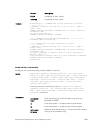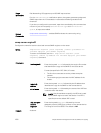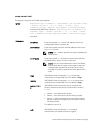
Command
Modes
CONFIGURATION
Command
History
This guide is platform-specific. For command information about other platforms,
refer to the relevant Dell Networking OS Command Line Reference Guide.
The following is a list of the Dell Networking OS version history for this command.
Version Description
9.7(0.0) Introduced on the S6000-ON.
9.4.(0.0) Added support for VRF.
9.0.2.0 Introduced on the S6000.
8.3.19.0 Introduced on the S4820T.
8.3.11.1 Introduced on the Z9000.
8.3.7.0 Introduced on the S4810.
7.6.1.0 Introduced on the S-Series.
7.5.1.0 Introduced on the C-Series.
E-Series legacy
command
Usage
Information
Changing the value of the SNMP Engine ID has important side effects. A user’s
password (entered on the command line) is converted to a message digest
algorithm (MD5) or secure hash algorithm (SHA) security digest. This digest is based
on both the password and the local Engine ID. The command line password is then
destroyed, as required by RFC 2274. Because of this deletion, if the local value of
the Engine ID changes, the security digests of SNMPv3 users is invalid and the users
will have to be reconfigured.
For the remote Engine ID, the host IP and UDP port are the indexes to the
command that are matched to either overwrite or remove the configuration.
Related
Commands
show snmp engineID — displays the SNMP engine and all the remote engines that
are configured on the router.
show running-config snmp — displays the SNMP running configuration.
snmp-server group
Configure a new SNMP group or a table that maps SNMP users to SNMP views.
Syntax
snmp-server group [group_name {1 | 2c | 3 {auth | noauth |
priv}}] [read name] [write name] [notify name] [access access-
list-name | ipv6 access-list-name | access-list-name ipv6
access-list-name]]
Simple Network Management Protocol (SNMP) and Syslog
1703


















